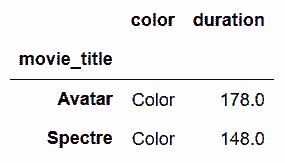# 第05章 布爾索引
```py
In[1]: import pandas as pd
import numpy as np
import matplotlib.pyplot as plt
%matplotlib inline
```
## 1\. 計算布爾值統計信息
```py
# 讀取movie,設定行索引是movie_title
In[2]: pd.options.display.max_columns = 50
In[3]: movie = pd.read_csv('data/movie.csv', index_col='movie_title')
movie.head()
Out[3]:
```
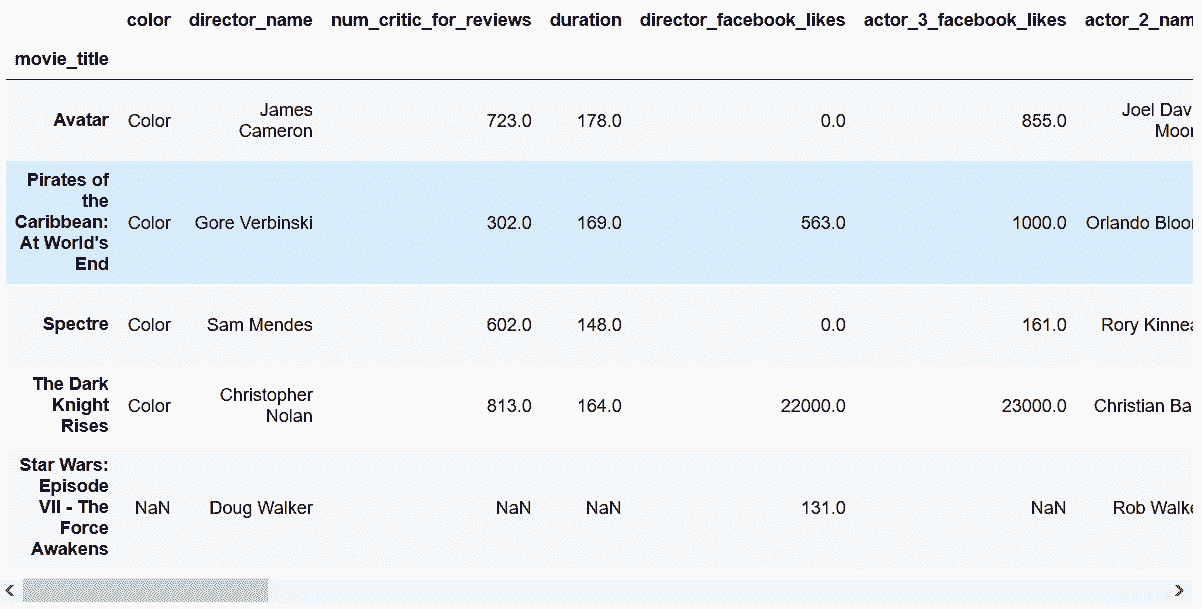
```py
# 判斷電影時長是否超過兩小時
In[4]: movie_2_hours = movie['duration'] > 120
movie_2_hours.head(10)
Out[4]: movie_title
Avatar True
Pirates of the Caribbean: At World's End True
Spectre True
The Dark Knight Rises True
Star Wars: Episode VII - The Force Awakens False
John Carter True
Spider-Man 3 True
Tangled False
Avengers: Age of Ultron True
Harry Potter and the Half-Blood Prince True
Name: duration, dtype: bool
```
```py
# 有多少時長超過兩小時的電影
In[5]: movie_2_hours.sum()
Out[5]: 1039
```
```py
# 超過兩小時的電影的比例
In[6]: movie_2_hours.mean()
Out[6]: 0.21135069161920261
```
```py
# 用describe()輸出一些該布爾Series信息
In[7]: movie_2_hours.describe()
Out[7]: count 4916
unique 2
top False
freq 3877
Name: duration, dtype: object
```
```py
# 實際上,dureation這列是有缺失值的,要想獲得真正的超過兩小時的電影的比例,需要先刪掉缺失值
In[8]: movie['duration'].dropna().gt(120).mean()
Out[8]: 0.21199755152009794
```
### 原理
```py
# 統計False和True值的比例
In[9]: movie_2_hours.value_counts(normalize=True)
Out[9]: False 0.788649
True 0.211351
Name: duration, dtype: float64
```
### 更多
```py
# 比較同一個DataFrame中的兩列
In[10]: actors = movie[['actor_1_facebook_likes', 'actor_2_facebook_likes']].dropna()
(actors['actor_1_facebook_likes'] > actors['actor_2_facebook_likes']).mean()
Out[10]: 0.97776871303283708
```
## 2\. 構建多個布爾條件
```py
In[11]: movie = pd.read_csv('data/movie.csv', index_col='movie_title')
movie.head()
Out[11]:
```
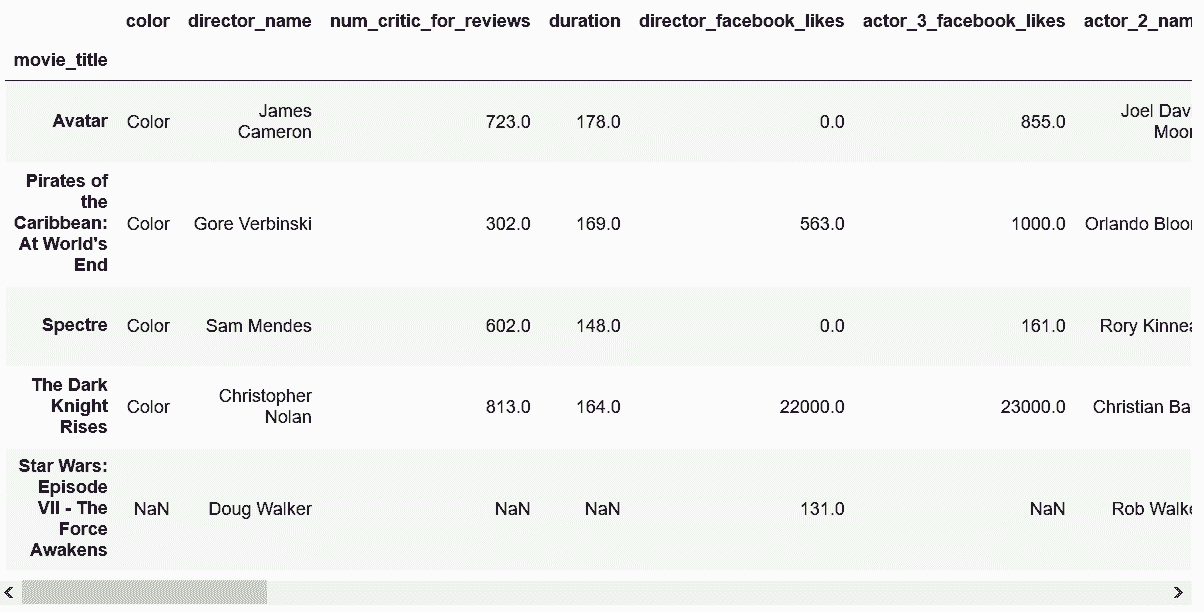
```py
# 創建多個布爾條件
In[12]: criteria1 = movie.imdb_score > 8
criteria2 = movie.content_rating == 'PG-13'
criteria3 = (movie.title_year < 2000) | (movie.title_year >= 2010)
criteria2.head()
Out[12]: movie_title
Avatar True
Pirates of the Caribbean: At World's End True
Spectre True
The Dark Knight Rises True
Star Wars: Episode VII - The Force Awakens False
Name: content_rating, dtype: bool
```
```py
# 將這些布爾條件合并成一個
In[13]: criteria_final = criteria1 & criteria2 & criteria3
criteria_final.head()
Out[13]: movie_title
Avatar False
Pirates of the Caribbean: At World's End False
Spectre False
The Dark Knight Rises True
Star Wars: Episode VII - The Force Awakens False
Name: content_rating, dtype: bool
```
### 更多
```py
# 在Pandas中,位運算符(&, |, ~)的優先級高于比較運算符,因此如過前面的條件3不加括號,就會報錯
In[14]: movie.title_year < 2000 | movie.title_year > 2009
---------------------------------------------------------------------------
TypeError Traceback (most recent call last)
/Users/Ted/anaconda/lib/python3.6/site-packages/pandas/core/ops.py in na_op(x, y)
882 try:
--> 883 result = op(x, y)
884 except TypeError:
/Users/Ted/anaconda/lib/python3.6/site-packages/pandas/core/ops.py in <lambda>(x, y)
130 names('rand_'), op('&')),
--> 131 ror_=bool_method(lambda x, y: operator.or_(y, x),
132 names('ror_'), op('|')),
TypeError: ufunc 'bitwise_or' not supported for the input types, and the inputs could not be safely coerced to any supported types according to the casting rule ''safe''
During handling of the above exception, another exception occurred:
ValueError Traceback (most recent call last)
/Users/Ted/anaconda/lib/python3.6/site-packages/pandas/core/ops.py in na_op(x, y)
900 y = bool(y)
--> 901 result = lib.scalar_binop(x, y, op)
902 except:
pandas/_libs/lib.pyx in pandas._libs.lib.scalar_binop (pandas/_libs/lib.c:15035)()
ValueError: Buffer dtype mismatch, expected 'Python object' but got 'double'
During handling of the above exception, another exception occurred:
TypeError Traceback (most recent call last)
<ipython-input-14-1e7ee3f1401c> in <module>()
----> 1 movie.title_year < 2000 | movie.title_year > 2009
/Users/Ted/anaconda/lib/python3.6/site-packages/pandas/core/ops.py in wrapper(self, other)
933 is_integer_dtype(np.asarray(other)) else fill_bool)
934 return filler(self._constructor(
--> 935 na_op(self.values, other),
936 index=self.index)).__finalize__(self)
937
/Users/Ted/anaconda/lib/python3.6/site-packages/pandas/core/ops.py in na_op(x, y)
903 raise TypeError("cannot compare a dtyped [{0}] array with "
904 "a scalar of type [{1}]".format(
--> 905 x.dtype, type(y).__name__))
906
907 return result
TypeError: cannot compare a dtyped [float64] array with a scalar of type [bool]
```
## 3\. 用布爾索引過濾
```py
# 讀取movie數據集,創建布爾條件
In[15]: movie = pd.read_csv('data/movie.csv', index_col='movie_title')
crit_a1 = movie.imdb_score > 8
crit_a2 = movie.content_rating == 'PG-13'
crit_a3 = (movie.title_year < 2000) | (movie.title_year > 2009)
final_crit_a = crit_a1 & crit_a2 & crit_a3
# 創建第二個布爾條件
In[16]: crit_b1 = movie.imdb_score < 5
crit_b2 = movie.content_rating == 'R'
crit_b3 = (movie.title_year >= 2000) & (movie.title_year <= 2010)
final_crit_b = crit_b1 & crit_b2 & crit_b3
# 將這兩個條件用或運算合并起來
In[17]: final_crit_all = final_crit_a | final_crit_b
final_crit_all.head()
Out[17]: movie_title
Avatar False
Pirates of the Caribbean: At World's End False
Spectre False
The Dark Knight Rises True
Star Wars: Episode VII - The Force Awakens False
dtype: bool
```
```py
# 用最終的布爾條件過濾數據
In[18]: movie[final_crit_all].head()
Out[18]:
```
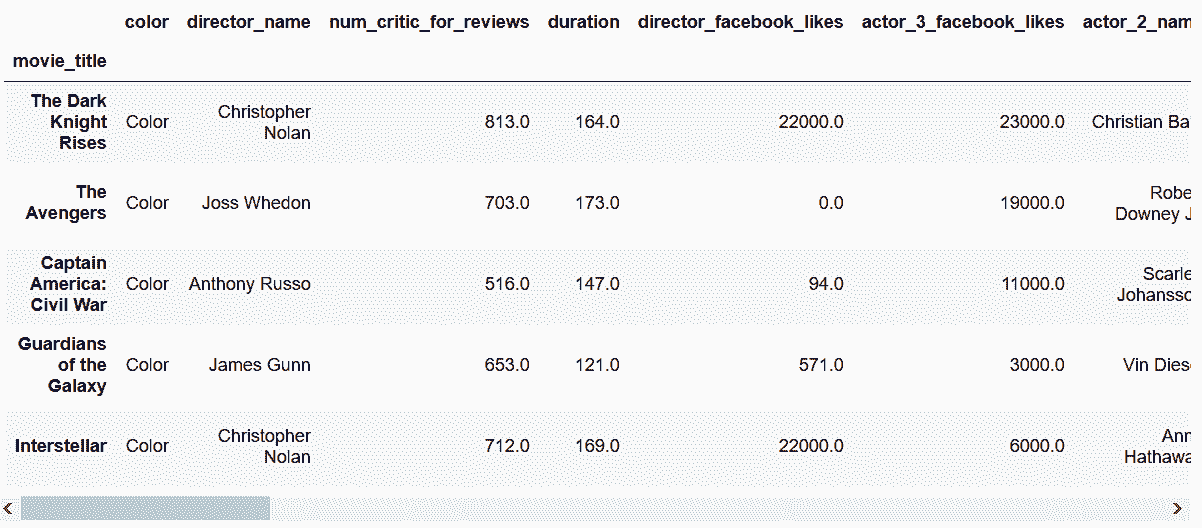
```py
# 使用loc,對指定的列做過濾操作,可以清楚地看到過濾是否起作用
In[19]: cols = ['imdb_score', 'content_rating', 'title_year']
movie_filtered = movie.loc[final_crit_all, cols]
movie_filtered.head(10)
Out[19]:
```
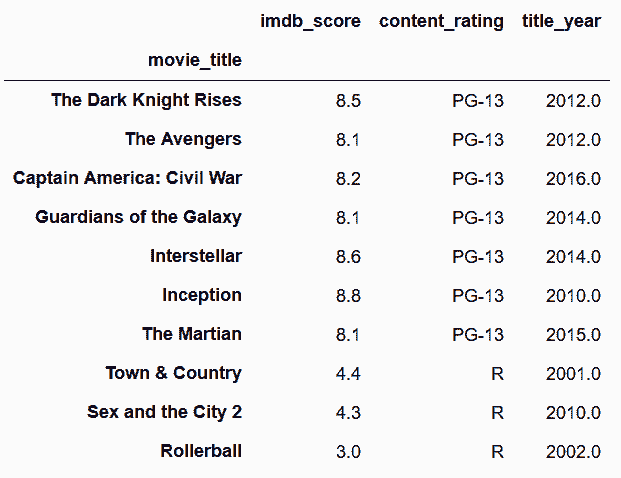
### 更多
```py
# 用一個長布爾表達式代替前面由短表達式生成的布爾條件
In[21]: final_crit_a2 = (movie.imdb_score > 8) & \
(movie.content_rating == 'PG-13') & \
((movie.title_year < 2000) | (movie.title_year > 2009))
final_crit_a2.equals(final_crit_a)
Out[21]:
```

## 4\. 用標簽索引代替布爾索引
```py
# 用布爾索引選取所有得克薩斯州的學校
>>> college = pd.read_csv('data/college.csv')
>>> college[college['STABBR'] == 'TX'].head()
```
```py
# 用STABBR作為行索引,然后用loc選取
In[22]: college2 = college.set_index('STABBR')
college2.loc['TX'].head()
Out[22]:
```
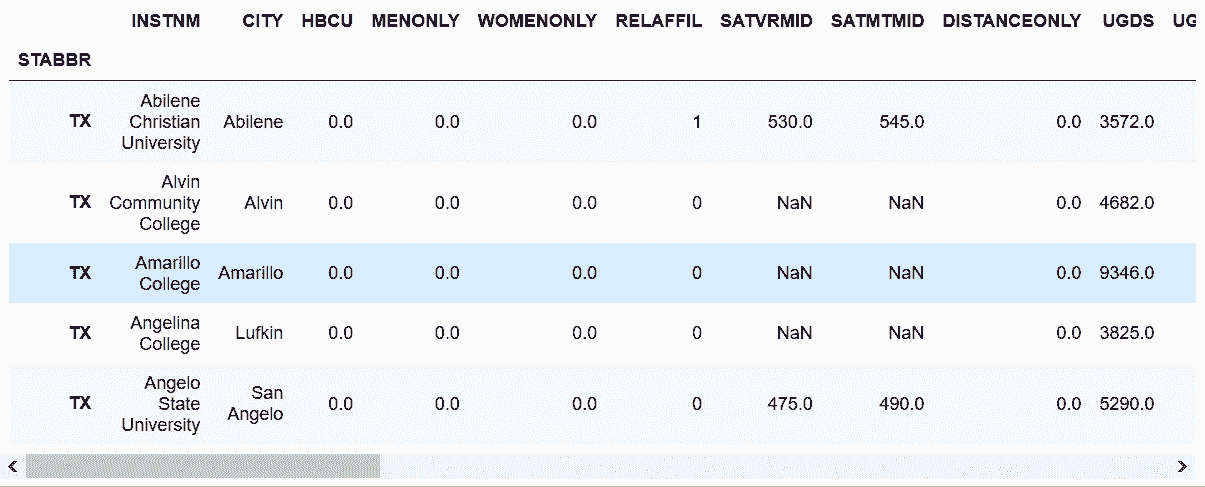
```py
# 比較二者的速度
In[23]: %timeit college[college['STABBR'] == 'TX']
1.51 ms ± 51.4 μs per loop (mean ± std. dev. of 7 runs, 1000 loops each)
In[24]: %timeit college2.loc['TX']
604 μs ± 23.9 μs per loop (mean ± std. dev. of 7 runs, 1000 loops each)
```
```py
# 使用STABBR作為行索引所用的時間
In[25]: %timeit college2 = college.set_index('STABBR')
1.28 ms ± 47.5 μs per loop (mean ± std. dev. of 7 runs, 1000 loops each)
```
### 更多
```py
# 使用布爾索引和標簽選取多列
In[26]: states =['TX', 'CA', 'NY']
college[college['STABBR'].isin(states)]
college2.loc[states].head()
Out[26]:
```

## 5\. 用唯一和有序索引選取
```py
# 讀取college數據集,使用STABBR作為行索引,檢查行索引是否有序
In[27]: college = pd.read_csv('data/college.csv')
college2 = college.set_index('STABBR')
In[28]: college2.index.is_monotonic
Out[28]: False
```
```py
# 將college2排序,存儲成另一個對象,查看其是否有序
In[29]: college3 = college2.sort_index()
college3.index.is_monotonic
Out[29]: True
```
```py
# 從這三個DataFrame選取得克薩斯州,比較速度
In[30]: %timeit college[college['STABBR'] == 'TX']
1.58 ms ± 63.8 μs per loop (mean ± std. dev. of 7 runs, 1000 loops each)
In[31]: %timeit college2.loc['TX']
622 μs ± 18.1 μs per loop (mean ± std. dev. of 7 runs, 1000 loops each)
In[32]: %timeit college3.loc['TX']
198 μs ± 5.8 μs per loop (mean ± std. dev. of 7 runs, 1000 loops each)
```
```py
# 使用INSTNM作為行索引,檢測行索引是否唯一
In[33]: college_unique = college.set_index('INSTNM')
college_unique.index.is_unique
Out[33]: True
```
```py
# 用布爾索引選取斯坦福大學
In[34]: college[college['INSTNM'] == 'Stanford University']
Out[34]:
```

```py
# 用行索引標簽選取斯坦福大學
In[35]: college_unique.loc['Stanford University']
Out[35]:
CITY Stanford
STABBR CA
HBCU 0
MENONLY 0
WOMENONLY 0
RELAFFIL 0
SATVRMID 730
SATMTMID 745
DISTANCEONLY 0
UGDS 7018
UGDS_WHITE 0.3752
UGDS_BLACK 0.0591
UGDS_HISP 0.1607
UGDS_ASIAN 0.1979
UGDS_AIAN 0.0114
UGDS_NHPI 0.0038
UGDS_2MOR 0.1067
UGDS_NRA 0.0819
UGDS_UNKN 0.0031
PPTUG_EF 0
CURROPER 1
PCTPELL 0.1556
PCTFLOAN 0.1256
UG25ABV 0.0401
MD_EARN_WNE_P10 86000
GRAD_DEBT_MDN_SUPP 12782
Name: Stanford University, dtype: object
```
```py
# 比較兩種方法的速度
In[36]: %timeit college[college['INSTNM'] == 'Stanford University']
1.44 ms ± 66 μs per loop (mean ± std. dev. of 7 runs, 1000 loops each)
In[37]: %timeit college_unique.loc['Stanford University']
191 μs ± 5.31 μs per loop (mean ± std. dev. of 7 runs, 10000 loops each)
```
### 更多
```py
# 使用CITY和STABBR兩列作為行索引,并進行排序
In[38]: college.index = college['CITY'] + ', ' + college['STABBR']
college = college.sort_index()
college.head()
Out[38]:
```

```py
# 選取所有Miami, FL的大學
In[39]: college.loc['Miami, FL'].head()
Out[39]:
```

```py
# 速度比較
In[40]: %%timeit
crit1 = college['CITY'] == 'Miami'
crit2 = college['STABBR'] == 'FL'
college[crit1 & crit2]
2.83 ms ± 82.4 μs per loop (mean ± std. dev. of 7 runs, 100 loops each)
In[41]: %timeit college.loc['Miami, FL']
226 μs ± 17.3 μs per loop (mean ± std. dev. of 7 runs, 1000 loops each)
```
```py
# 判斷這兩個條件是否相同
In[42]: college[(college['CITY'] == 'Miami') & (college['STABBR'] == 'FL')].equals(college.loc['Miami, FL'])
Out[42]: True
```
## 6\. 觀察股價
```py
# 讀取Schlumberger stock數據集,行索引設為Date列,并將其轉變為DatetimeIndex
In[43]: slb = pd.read_csv('data/slb_stock.csv', index_col='Date', parse_dates=['Date'])
slb.head()
Out[43]:
```
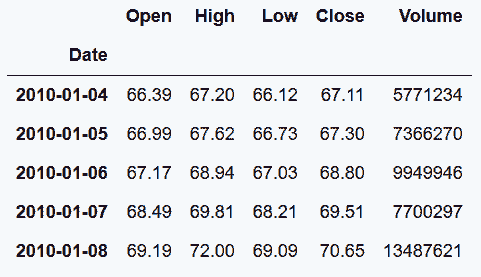
```py
# 選取Close這列,用describe返回統計信息
In[44]: slb_close = slb['Close']
slb_summary = slb_close.describe(percentiles=[.1, .9])
slb_summary
Out[44]: count 1895.000000
mean 79.121905
std 11.767802
min 51.750000
10% 64.892000
50% 78.000000
90% 93.248000
max 117.950000
Name: Close, dtype: float64
```
```py
# 用布爾索引選取最高和最低10%的收盤價
In[45]: upper_10 = slb_summary.loc['90%']
lower_10 = slb_summary.loc['10%']
criteria = (slb_close < lower_10) | (slb_close > upper_10)
slb_top_bottom_10 = slb_close[criteria]
# 過濾出的數據使用灰色,所有的收盤價使用黑色,用matplotlib在十分之一和十分之九分位數位置畫橫線
In[46]: slb_close.plot(color='black', figsize=(12,6))
slb_top_bottom_10.plot(marker='o', style=' ', ms=4, color='lightgray')
xmin = criteria.index[0]
xmax = criteria.index[-1]
plt.hlines(y=[lower_10, upper_10], xmin=xmin, xmax=xmax,color='black')
Out[46]: <matplotlib.collections.LineCollection at 0x1174b3278>
```
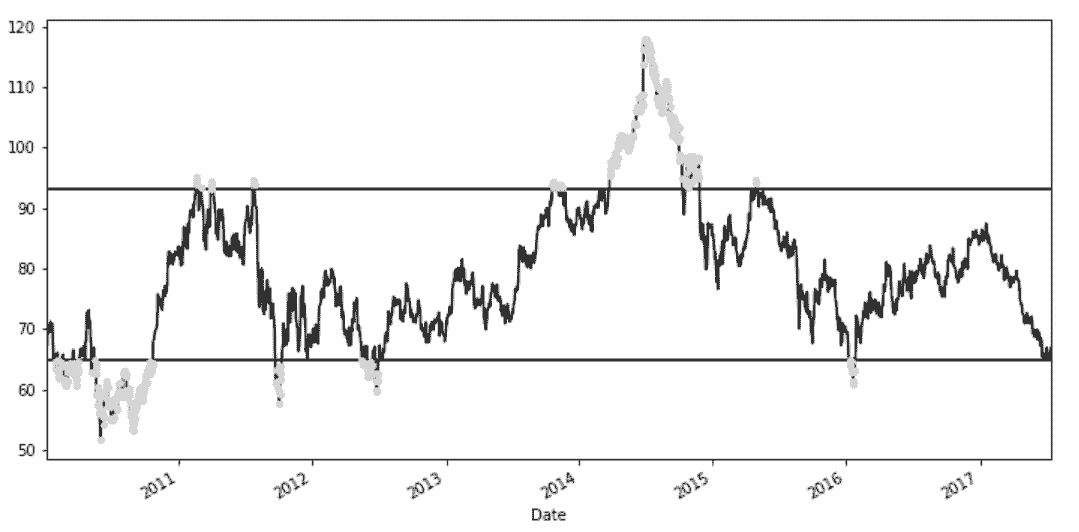
### 更多
```py
# 使用fill_between可以在兩條線之間填充顏色
In[47]: slb_close.plot(color='black', figsize=(12,6))
plt.hlines(y=[lower_10, upper_10],
xmin=xmin, xmax=xmax,color='lightgray')
plt.fill_between(x=criteria.index, y1=lower_10,
y2=slb_close.values, color='black')
plt.fill_between(x=criteria.index,y1=lower_10,
y2=slb_close.values, where=slb_close < lower_10,
color='lightgray')
plt.fill_between(x=criteria.index, y1=upper_10,
y2=slb_close.values, where=slb_close > upper_10,
color='lightgray')
Out[47]:
```
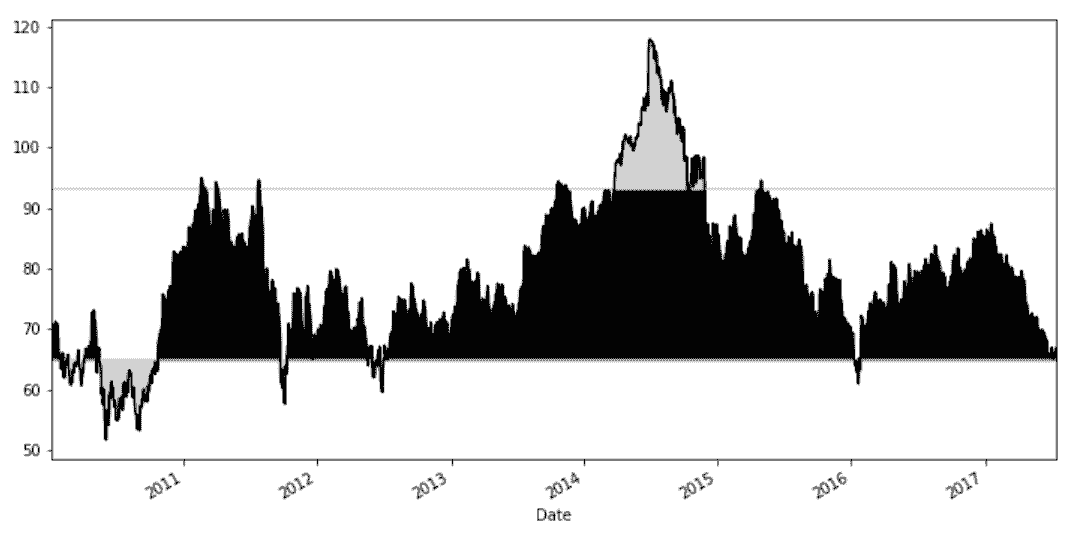
## 7\. 翻譯SQL的WHERE語句
```py
# 讀取employee數據集
In[48]: employee = pd.read_csv('data/employee.csv')
# 對各項做下了解
In[49]: employee.DEPARTMENT.value_counts().head()
Out[49]: Houston Police Department-HPD 638
Houston Fire Department (HFD) 384
Public Works & Engineering-PWE 343
Health & Human Services 110
Houston Airport System (HAS) 106
Name: DEPARTMENT, dtype: int64
In[50]: employee.GENDER.value_counts()
Out[50]: Male 1397
Female 603
Name: GENDER, dtype: int64
In[51]: employee.BASE_SALARY.describe().astype(int)
Out[51]: count 1886
mean 55767
std 21693
min 24960
25% 40170
50% 54461
75% 66614
max 275000
Name: BASE_SALARY, dtype: int64
```
```py
# 創建布爾條件,并從'UNIQUE_ID', 'DEPARTMENT', 'GENDER', 'BASE_SALARY'四列選取
In[52]: depts = ['Houston Police Department-HPD',
'Houston Fire Department (HFD)']
criteria_dept = employee.DEPARTMENT.isin(depts)
criteria_gender = employee.GENDER == 'Female'
criteria_sal = (employee.BASE_SALARY >= 80000) & \
(employee.BASE_SALARY <= 120000)
In[53]: criteria_final = criteria_dept & criteria_gender & criteria_sal
In[54]: select_columns = ['UNIQUE_ID', 'DEPARTMENT', 'GENDER', 'BASE_SALARY']
employee.loc[criteria_final, select_columns].head()
Out[54]:
```

### 更多
```py
# 使用between選取80000到120000之間的薪水
In[55]: criteria_sal = employee.BASE_SALARY.between(80000, 120000)
# 排除最常出現的5家單位
In[56]: top_5_depts = employee.DEPARTMENT.value_counts().index[:5]
criteria = ~employee.DEPARTMENT.isin(top_5_depts)
employee[criteria].head()
Out[56]:
```
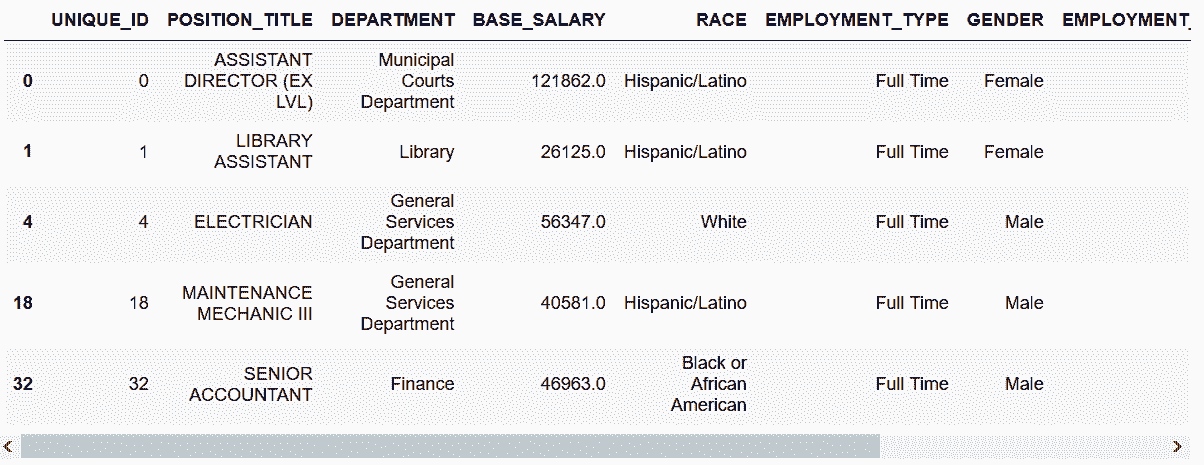
功能一樣的SQL語句是:
```py
SELECT
*
FROM
EMPLOYEE
WHERE
DEPARTMENT not in
(
SELECT
DEPARTMENT
FROM (
SELECT
DEPARTMENT,
COUNT(1) as CT
FROM
EMPLOYEE
GROUP BY
DEPARTMENT
ORDER BY
CT DESC
LIMIT 5
)
);
```
## 8\. 確定股票收益的正態值
```py
# 加載亞馬遜的股票數據,使用Data作為行索引
In[57]: amzn = pd.read_csv('data/amzn_stock.csv', index_col='Date', parse_dates=['Date'])
amzn.head()
Out[57]:
```
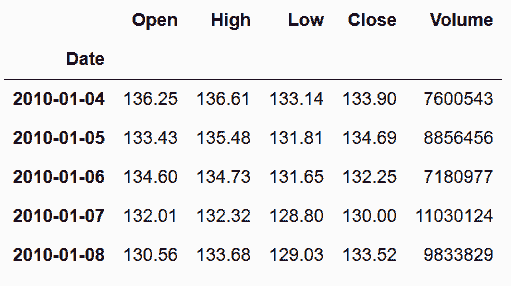
```py
# 選取Close收盤價,用pct_change()計算每日回報率
In[58]: amzn_daily_return = amzn.Close.pct_change()
amzn_daily_return.head()
Out[58]: Date
2010-01-04 NaN
2010-01-05 0.005900
2010-01-06 -0.018116
2010-01-07 -0.017013
2010-01-08 0.027077
Name: Close, dtype: float64
```
```py
# 去掉缺失值,畫一張柱狀圖,查看分布情況
In[59]: amzn_daily_return = amzn_daily_return.dropna()
amzn_daily_return.hist(bins=20)
Out[59]: <matplotlib.axes._subplots.AxesSubplot at 0x1174b3128>
```
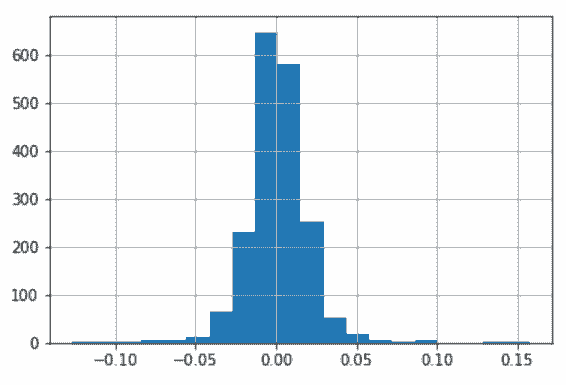
```py
# 計算平均值和標準差
In[60]: mean = amzn_daily_return.mean()
std = amzn_daily_return.std()
# 計算每個數據的z-score的絕對值:z-score是遠離平均值的標準差值得個數
In[61]: abs_z_score = amzn_daily_return.sub(mean).abs().div(std)
# 計算位于1,2,3個標準差之內的收益率的比例
In[62]: pcts = [abs_z_score.lt(i).mean() for i in range(1,4)]
print('{:.3f} fall within 1 standard deviation. '
'{:.3f} within 2 and {:.3f} within 3'.format(*pcts))
0.787 fall within 1 standard deviation. 0.956 within 2 and 0.985 within 3
```
### 更多
```py
# 將上面的方法整合成一個函數
In[63]: def test_return_normality(stock_data):
close = stock_data['Close']
daily_return = close.pct_change().dropna()
daily_return.hist(bins=20)
mean = daily_return.mean()
std = daily_return.std()
abs_z_score = abs(daily_return - mean) / std
pcts = [abs_z_score.lt(i).mean() for i in range(1,4)]
print('{:.3f} fall within 1 standard deviation. '
'{:.3f} within 2 and {:.3f} within 3'.format(*pcts))
In[64]: slb = pd.read_csv('data/slb_stock.csv',
index_col='Date', parse_dates=['Date'])
test_return_normality(slb)
0.742 fall within 1 standard deviation. 0.946 within 2 and 0.986 within 3
```
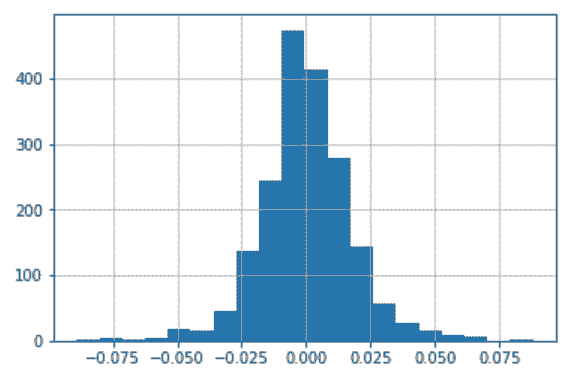
## 9\. 使用查詢方法提高布爾索引的可讀性
```py
# 讀取employee數據,確定選取的部門和列
In[65]: employee = pd.read_csv('data/employee.csv')
depts = ['Houston Police Department-HPD', 'Houston Fire Department (HFD)']
select_columns = ['UNIQUE_ID', 'DEPARTMENT', 'GENDER', 'BASE_SALARY']
# 創建查詢字符串,并執行query方法
In[66]: qs = "DEPARTMENT in @depts " \
"and GENDER == 'Female' " \
"and 80000 <= BASE_SALARY <= 120000"
emp_filtered = employee.query(qs)
emp_filtered[select_columns].head()
Out[66]:
```
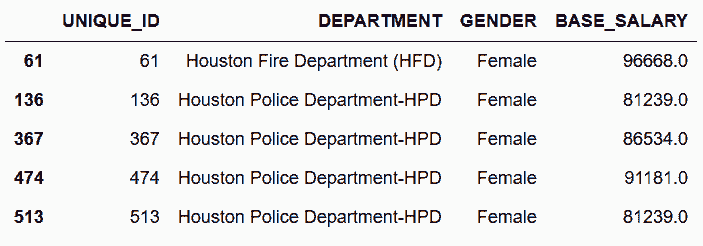
### 更多
```py
# 若要不使用部門列表,也可以使用下面的方法
In[67]: top10_depts = employee.DEPARTMENT.value_counts().index[:10].tolist()
qs = "DEPARTMENT not in @top10_depts and GENDER == 'Female'"
employee_filtered2 = employee.query(qs)
employee_filtered2[['DEPARTMENT', 'GENDER']].head()
Out[67]:
```

## 10\. 用where方法保留Series
```py
# 讀取movie數據集,movie_title作為行索引,actor_1_facebook_likes列刪除缺失值
In[68]: movie = pd.read_csv('data/movie.csv', index_col='movie_title')
fb_likes = movie['actor_1_facebook_likes'].dropna()
fb_likes.head()
Out[68]: movie_title
Avatar 1000.0
Pirates of the Caribbean: At World's End 40000.0
Spectre 11000.0
The Dark Knight Rises 27000.0
Star Wars: Episode VII - The Force Awakens 131.0
Name: actor_1_facebook_likes, dtype: float64
```
```py
# 使用describe獲得對數據的認知
In[69]: fb_likes.describe(percentiles=[.1, .25, .5, .75, .9]).astype(int)
Out[69]: count 4909
mean 6494
std 15106
min 0
10% 240
25% 607
50% 982
75% 11000
90% 18000
max 640000
Name: actor_1_facebook_likes, dtype: int64
```
```py
# 作用和前面相同(這里是作者代碼弄亂了)
In[70]: fb_likes.describe(percentiles=[.1,.25,.5,.75,.9])
Out[70]: count 4909.000000
mean 6494.488491
std 15106.986884
min 0.000000
10% 240.000000
25% 607.000000
50% 982.000000
75% 11000.000000
90% 18000.000000
max 640000.000000
Name: actor_1_facebook_likes, dtype: float64
```
```py
# 畫一張柱狀圖
In[71]: fb_likes.hist()
Out[71]: <matplotlib.axes._subplots.AxesSubplot at 0x10f9fbe80>
```
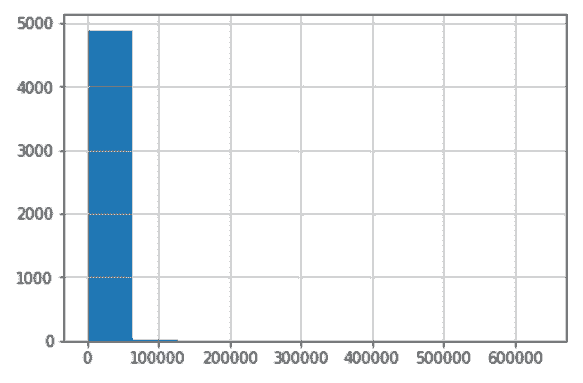
```py
# 檢測小于20000個喜歡的的比例
In[72]: criteria_high = fb_likes < 20000
criteria_high.mean().round(2)
Out[71]: 0.91000000000000003
```
```py
# where條件可以返回一個同樣大小的Series,但是所有False會被替換成缺失值
In[73]: fb_likes.where(criteria_high).head()
Out[73]: movie_title
Avatar 1000.0
Pirates of the Caribbean: At World's End NaN
Spectre 11000.0
The Dark Knight Rises NaN
Star Wars: Episode VII - The Force Awakens 131.0
Name: actor_1_facebook_likes, dtype: float64
```
```py
# 第二個參數other,可以讓你控制替換值
In[74]: fb_likes.where(criteria_high, other=20000).head()
Out[74]: movie_title
Avatar 1000.0
Pirates of the Caribbean: At World's End 20000.0
Spectre 11000.0
The Dark Knight Rises 20000.0
Star Wars: Episode VII - The Force Awakens 131.0
Name: actor_1_facebook_likes, dtype: float64
```
```py
# 通過where條件,設定上下限的值
In[75]: criteria_low = fb_likes > 300
fb_likes_cap = fb_likes.where(criteria_high, other=20000)\
.where(criteria_low, 300)
fb_likes_cap.head()
Out[75]: movie_title
Avatar 1000.0
Pirates of the Caribbean: At World's End 20000.0
Spectre 11000.0
The Dark Knight Rises 20000.0
Star Wars: Episode VII - The Force Awakens 300.0
Name: actor_1_facebook_likes, dtype: float64
```
```py
# 原始Series和修改過的Series的長度是一樣的
In[76]: len(fb_likes), len(fb_likes_cap)
Out[76]: (4909, 4909)
```
```py
# 再做一張柱狀圖,效果好多了
In[77]: fb_likes_cap.hist()
Out[77]: <matplotlib.axes._subplots.AxesSubplot at 0x10eeea8d0>
```
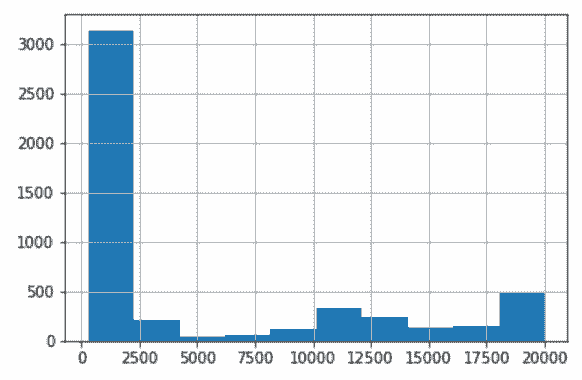
```py
In[78]: fb_likes_cap2 = fb_likes.clip(lower=300, upper=20000)
fb_likes_cap2.equals(fb_likes_cap)
Out[78]: True
```
## 11\. 對DataFrame的行做mask
```py
# 讀取movie,根據條件進行篩選
In[79]: movie = pd.read_csv('data/movie.csv', index_col='movie_title')
c1 = movie['title_year'] >= 2010
c2 = movie['title_year'].isnull()
criteria = c1 | c2
# 使用mask方法,使所有滿足條件的數據消失
In[80]: movie.mask(criteria).head()
Out[80]:
```
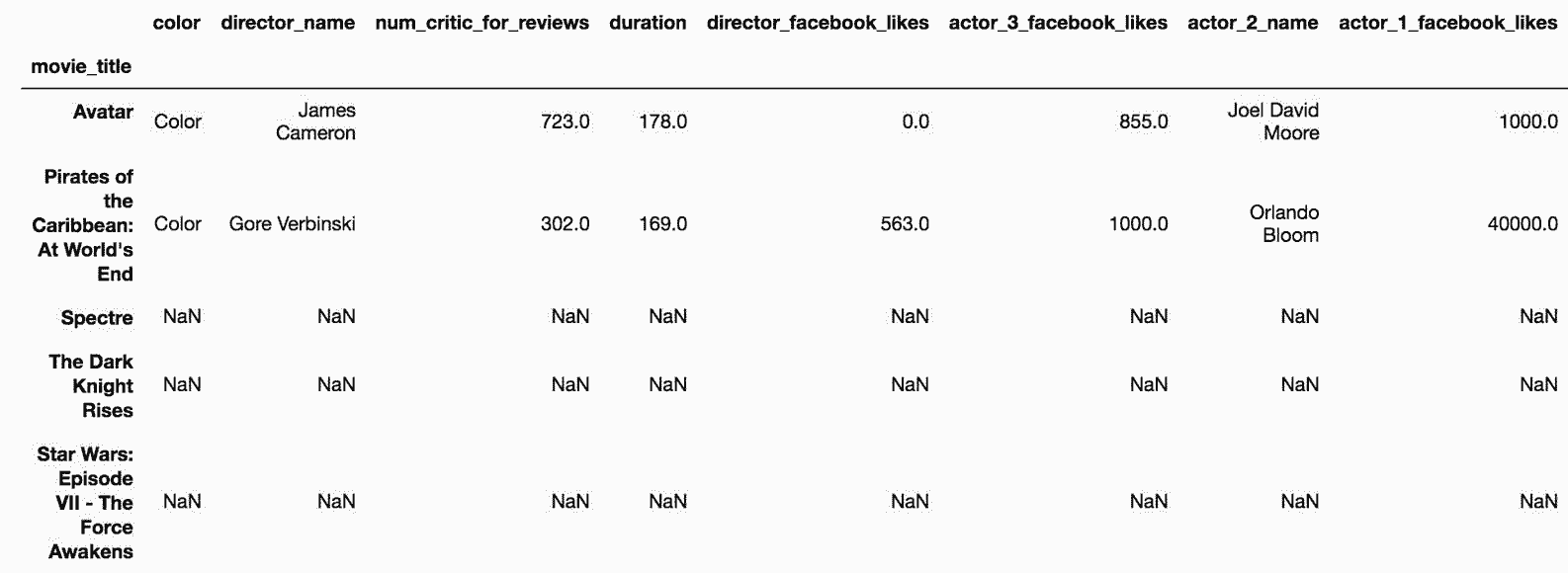
```py
# 去除缺失值
In[81]: movie_mask = movie.mask(criteria).dropna(how='all')
movie_mask.head()
Out[81]:
```

```py
# 用布爾索引選取title_year小于2010的電影
In[82]: movie_boolean = movie[movie['title_year'] < 2010]
movie_boolean.head()
Out[82]:
```
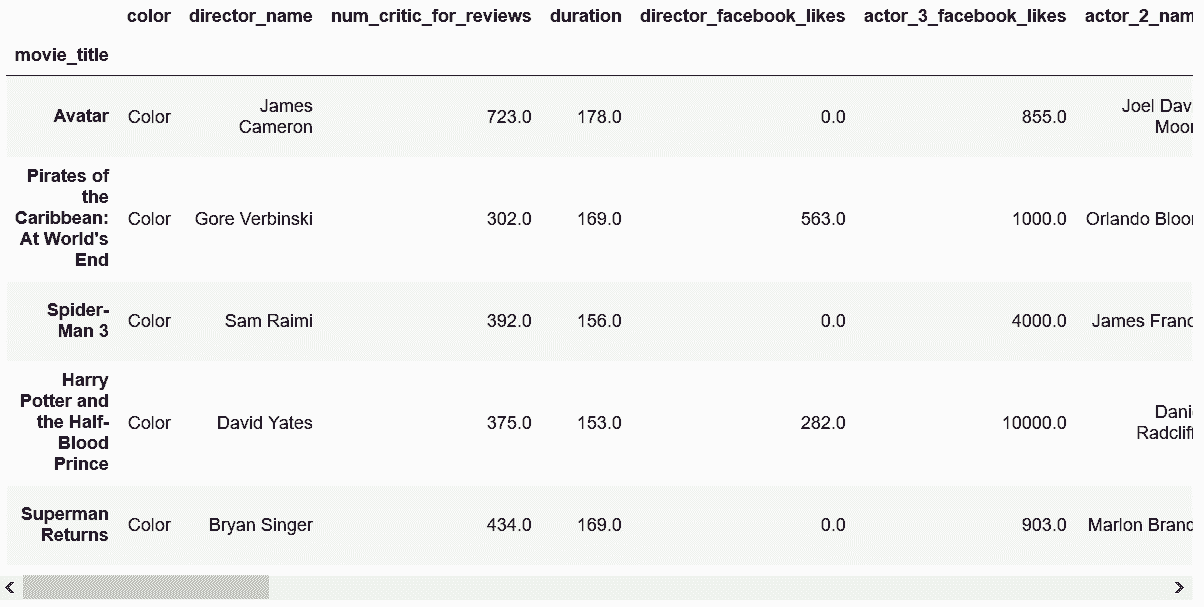
```py
# 判斷這兩種方法是否相同
In[83]: movie_mask.equals(movie_boolean)
Out[83]: False
```
```py
# 判斷二者的形狀是否相同
In[84]: movie_mask.shape == movie_boolean.shape
Out[84]: True
```
```py
# mask方法產生了許多缺失值,缺失值是float類型,所以之前是整數型的列都變成了浮點型
In[85]: movie_mask.dtypes == movie_boolean.dtypes
Out[85]:
color True
director_name True
num_critic_for_reviews True
duration True
director_facebook_likes True
actor_3_facebook_likes True
actor_2_name True
actor_1_facebook_likes True
gross True
genres True
actor_1_name True
num_voted_users False
cast_total_facebook_likes False
actor_3_name True
facenumber_in_poster True
plot_keywords True
movie_imdb_link True
num_user_for_reviews True
language True
country True
content_rating True
budget True
title_year True
actor_2_facebook_likes True
imdb_score True
aspect_ratio True
movie_facebook_likes False
dtype: bool
```
```py
# Pandas有一個assert_frame_equal方法,可以判斷兩個Pandas對象是否一樣,而不檢測其數據類型
In[86]: from pandas.testing import assert_frame_equal
assert_frame_equal(movie_boolean, movie_mask, check_dtype=False)
```
### 更多
```py
# 比較mask和布爾索引的速度,兩者相差了一個數量級
In[87]: %timeit movie.mask(criteria).dropna(how='all')
11.1 ms ± 48.3 μs per loop (mean ± std. dev. of 7 runs, 100 loops each)
In[88]: %timeit movie[movie['title_year'] < 2010]
1.12 ms ± 36.7 μs per loop (mean ± std. dev. of 7 runs, 1000 loops each)
```
## 12\. 使用布爾值、整數、標簽進行選取
```py
# 讀取movie,根據布爾條件選取
In[89]: movie = pd.read_csv('data/movie.csv', index_col='movie_title')
c1 = movie['content_rating'] == 'G'
c2 = movie['imdb_score'] < 4
criteria = c1 & c2
In[90]: movie_loc = movie.loc[criteria]
movie_loc.head()
Out[90]:
```
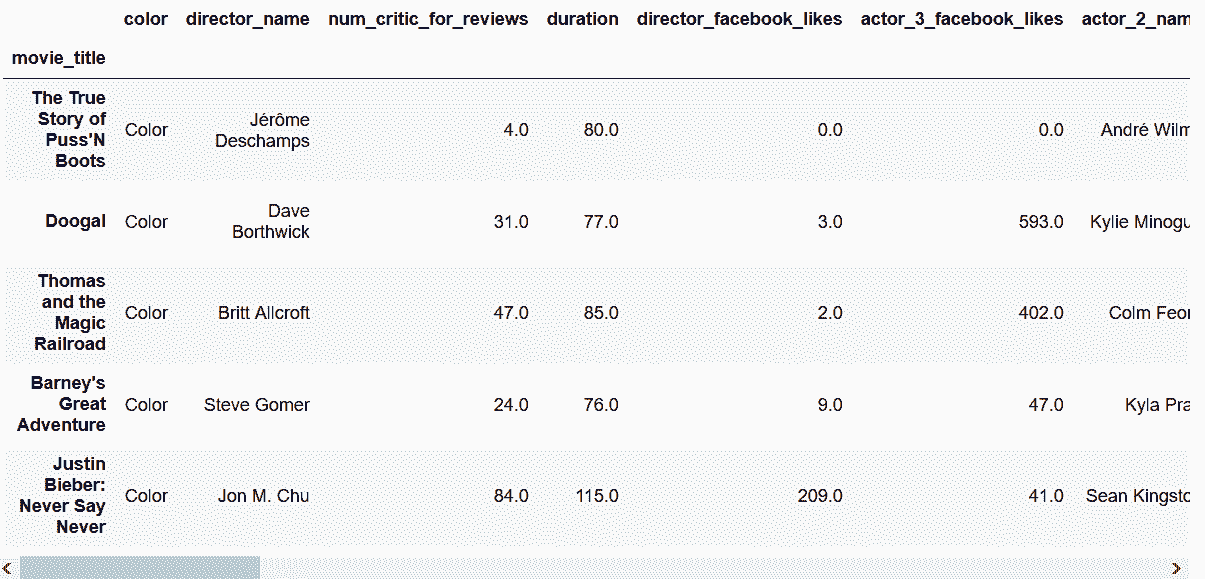
```py
# 檢查loc條件和布爾條件創建出來的兩個DataFrame是否一樣
In[91]: movie_loc.equals(movie[criteria])
Out[91]: True
```
```py
# 嘗試用.iloc使用布爾索引
In[92]: movie_iloc = movie.iloc[criteria]
---------------------------------------------------------------------------
ValueError Traceback (most recent call last)
<ipython-input-92-24a12062c6c3> in <module>()
----> 1 movie_iloc = movie.iloc[criteria]
/Users/Ted/anaconda/lib/python3.6/site-packages/pandas/core/indexing.py in __getitem__(self, key)
1326 else:
1327 key = com._apply_if_callable(key, self.obj)
-> 1328 return self._getitem_axis(key, axis=0)
1329
1330 def _is_scalar_access(self, key):
/Users/Ted/anaconda/lib/python3.6/site-packages/pandas/core/indexing.py in _getitem_axis(self, key, axis)
1731
1732 if is_bool_indexer(key):
-> 1733 self._has_valid_type(key, axis)
1734 return self._getbool_axis(key, axis=axis)
1735
/Users/Ted/anaconda/lib/python3.6/site-packages/pandas/core/indexing.py in _has_valid_type(self, key, axis)
1588 "indexing on an integer type "
1589 "is not available")
-> 1590 raise ValueError("iLocation based boolean indexing cannot use "
1591 "an indexable as a mask")
1592 return True
ValueError: iLocation based boolean indexing cannot use an indexable as a mask
```
```py
# 但是,卻可以使用布爾值得ndarray,用values可以取出array
In[93]: movie_iloc = movie.iloc[criteria.values]
In[94]: movie_iloc.equals(movie_loc)
Out[94]: True
In[95]: movie.loc[criteria.values]
Out[95]:
```
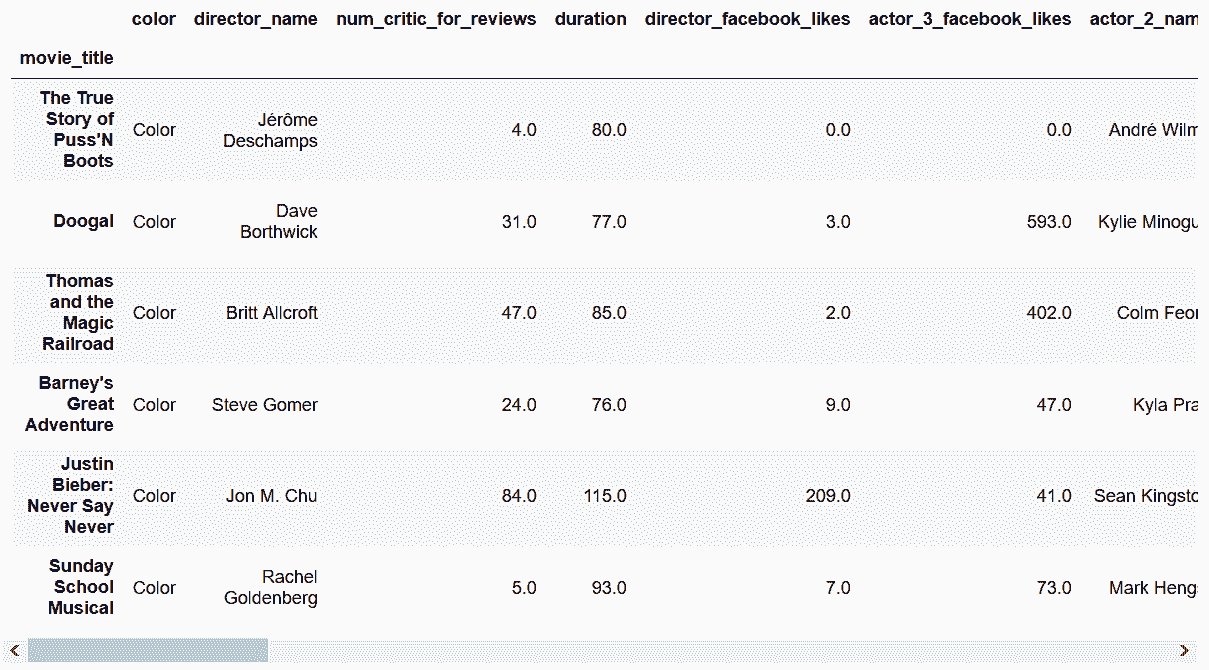
```py
# 布爾索引也可以用來選取列
In[96]: criteria_col = movie.dtypes == np.int64
criteria_col.head()
Out[96]: color False
director_name False
num_critic_for_reviews False
duration False
director_facebook_likes False
dtype: bool
```
```py
In[97]: movie.loc[:, criteria_col].head()
Out[97]:
```

```py
# 因為criteria_col是包含行索引的一個Series,必須要使用底層的ndarray,才能使用,iloc
In[98]: movie.iloc[:, criteria_col.values].head()
Out[98]:
```

```py
# 選取'content_rating', 'imdb_score', 'title_year', 'gross'四列,按照imdb_score升序排列
In[99]: cols = ['content_rating', 'imdb_score', 'title_year', 'gross']
movie.loc[criteria, cols].sort_values('imdb_score')
Out[99]:
```
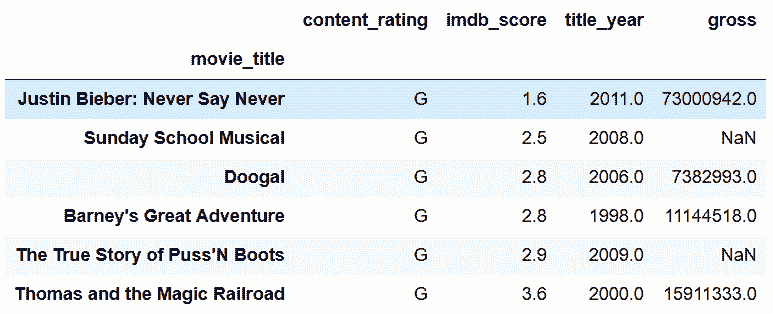
```py
# 用get_loc獲取這四列的整數位置
In[100]: col_index = [movie.columns.get_loc(col) for col in cols]
col_index
Out[100]: [20, 24, 22, 8]
```
```py
# 這時候就可以使用iloc了
In[101]: movie.iloc[criteria.values, col_index].sort_values('imdb_score')
Out[101]:
```
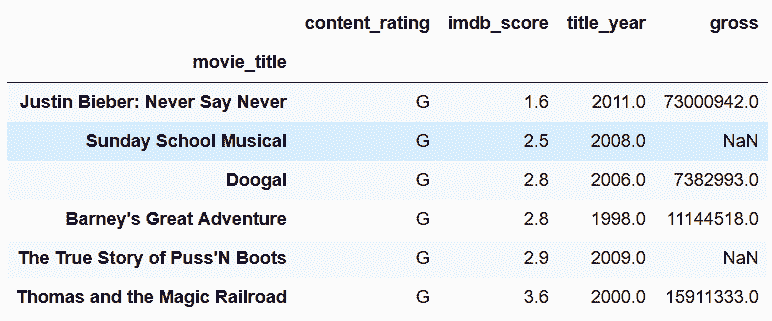
### 原理
```py
# 查看Series的底層結構
In[102]: a = criteria.values
a[:5]
Out[102]: array([False, False, False, False, False], dtype=bool)
In[103]: len(a), len(criteria)
Out[103]: (4916, 4916)
```
### 更多
```py
# 傳入的布爾索引可以跟要操作的DataFrame長度不同
In[104]: movie.loc[[True, False, True], [True, False, False, True]]
Out[104]:
```
